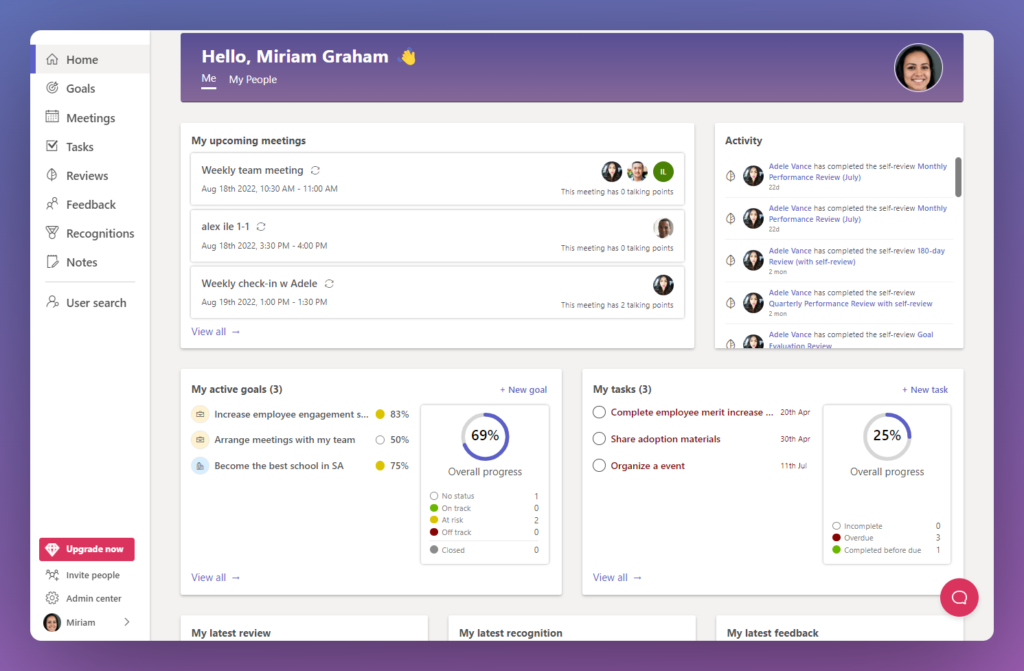Questioning the purpose of performance management is definitely tricky process. Performance management covers an incredibly massive area. That means, when you ask the question “What is the purpose of performance management?” you are setting yourself up for a classic “It depends”.
While “It depends.” can often be seen as a copout, or lawyer talk, in this case it really does depend. Performance management can serve multiple different purposes such as setting clear expectations, providing feedback, recognizing employees, or simply holding people accountable. Out of all of these, what is the most important purpose of performance management? Well, you’ll simply have to scroll down and find out. Spoilers: IT ABSOLUTELY DEPENDS ON YOUR MANAGEMENT STYLE!
Table of Contents
What is the purpose of performance management?
1. Employee Development
One of the key purposes of performance management is to help employees develop their skills and reach their potential. Performance management helps employees in understanding what they need to do to improve their performance by defining clear goals and offering frequent feedback.
Constructive criticism, suggestions for improvement, and acknowledgment of accomplishments and strengths can all be included in this feedback. Performance management can improve employee engagement, motivation, and job satisfaction by putting an emphasis on personal growth. Better performance increased job security, and more prospects for growth may result from this.
2. Employee Engagement
Another key purpose of performance management is to keep employees engaged and motivated. Engaged employees are more productive, more creative, and more committed to their work. When you’re managing performance, keeping your employees engaged should be an absolutely crucial part of your agenda. Remember, the purpose of performance management isn’t to just measure, evaluate, and monitor performance. It is to enhance it.
While archaic approaches to performance management can be a bit too focused on what then employee can do for the organization, it should be the other way around. One of the easiest way to boost performance in the workplace and achieve the core purpose of performance management is to simply provide your employees with an exciting environment. If you are looking to build upon your employee engagement skills, or you are simply looking for some fresh ideas on the matter, here are 10 creative Employee Engagement Ideas.
3. Clarifying Your Expectations
Letting employees know just what exactly is required of them. The phrase “Setting clear goals and expectations” just might be the most overused sentence in performance management today. That, however, doesn’t mean that it isn’t the right sentiment. Whether you are using OKRs or KPIs, setting goals in a clear and comprehensible manner is a crucial purpose of performance management.
Employers can use performance management to assist employees in understanding their expectations. When performance management is practiced with the purpose of setting clear expectations, employees see a clear path to success and a positive future within your organization.
If you’ve read any of our articles on the top employee engagement trends of 2023, then you will know that this is a gold mine in terms of employee engagement!Think of it as having a GPS for your career, but instead of saying “turn left in 500 feet”, it says “here’s what you need to do to get that promotion”.
4. Monitoring and Evaluating Performance
Just because an answer is obvious, that doesn’t make it any less factual! At its heart, the most basic purpose of performance management can be seen as monitoring and evaluating performance. There are multiple incredible tools leaders can use to do monitor and evaluate performance. Conducting regular performance reviews, is one of the best practices. you can implement in this regard.
Effective performance evaluation and monitoring requires the use of clear performance metrics and goals. These metrics should be aligned with the organization’s objectives and should be communicated clearly to employees. If you’re not sure about how often you should conduct performance reviews, you should definitely check out our article on Employee Performance Review Frequency.
5. Rewarding and Recognizing Good Performance
As we progressed down the list, we think that many of you picked up on the fact that non of these purposes of performance management are mutually exclusive. In fact, they often follow each other! You helped your employees grow? Fantastic! You set clear expectations and goals for them to follow? Incredible! You monitored and evaluated their performance? Good on ya! What next? Well, it is time to practice some good old fashioned employee recognition!
Employee recognition is a really fun and necessary purpose of performance management. Employee recognition can come in many shapes! It can come in the form of a simple thank you, public congratulations, or free coffee! No matter how you practice it, recognizing your employees is a huge part of performance management.
Digitizing Performance Management
If you’ve been paying attention, you surely noticed that many of these steps can heavily benefit from the assistance of performance management software. Performance management is a tricky landscape to navigate, especially with the advent of remote and hybrid work. That is why taking advantage of the existing technology is a great idea! That is why we made this list: Top Performance Management Software of 2024.

That being said, if your organization uses Microsoft Teams, then we already have an answer for you. Teamflect is an all-in-one performance management software designed specifically for Microsoft Teams. Teamflect can help you fulfill every single purpose of performance management we listed above, and then some! With Teamflect, you can:
- Manageme performance without leaving Microsoft Teams
- Assign, track, and automate tasks.
- Set goals & OKRs.
- Conduct performance reviews.
- Have access to incredible employee feedback templates.
- Conduct employee engagement surveys.
- And more!
What Are the Benefits of Performance Management?
Improved individual performance
Performance management identifies areas for improvement, sets clear goals and targets, and provides regular feedback to help employees perform better as a whole. This results in increased productivity and efficiency, as well as higher quality work.
Enhanced team performance
Performance management can also improve the performance of teams by improving communication and collaboration, aligning goals and objectives, and identifying areas for improvement, leading to better teamwork and more effective problem-solving, which can ultimately result in better outcomes for the organization.
Organizational growth and success
By aligning individual and team performance with organizational objectives, performance management can help organizations achieve business objectives and enhance their reputation and brand image. Some benefits of this includes: increased customer satisfaction, improved market share, and enhanced financial performance.
What is Performance Management?
Organizations utilize performance management as a method to define objectives, track results, and assess performance. It entails laying down clear expectations for employees, giving them feedback on a regular basis, figuring out their strengths and shortcomings, and rewarding excellent work. Organizations can use performance management to make sure that staff members are contributing to the accomplishment of corporate goals and are upholding the organization’s standards for quality and productivity.




